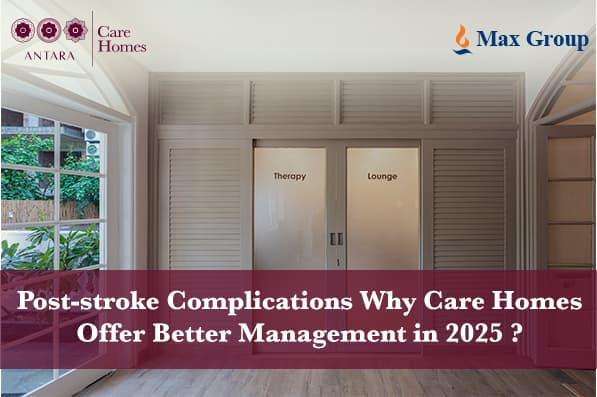
Loading...

Loading...
2025-05-14
Antara
Stroke affects one in four people during their lifetime, making it a leading cause of death and disability worldwide. Post-stroke complications management remains a critical challenge for stroke survivors globally, many of whom struggle with ongoing health issues. The scale of this problem continues to grow as populations age and stroke fatality rates decline.

The transition from hospital to home presents significant hurdles for stroke patients and their families. After a stroke, many individuals live with ongoing neurological issues and reduced mobility, highlighting the need for dedicated, long-term care. Delays in receiving timely follow-up care after discharge create a critical gap in stroke recovery. Many people recovering from stroke have coexisting conditions like high blood pressure and diabetes, which highlights why specialised environments may offer better solutions.
Care homes provide a compelling alternative with their 24-hour support systems. Studies show that comprehensive post-stroke care programmes can significantly reduce recurrent vascular events while improving quality of life. Additionally, quality care facilities lower the risk of infections, decrease re-hospitalisation rates, and cut overall healthcare costs—making them increasingly valuable in the evolving healthcare landscape of 2025.
Stroke complications affect every aspect of a patient's life, creating ripple effects far beyond the initial brain injury. Each stroke is different. Consequently, the path to recovery varies significantly for each person.
Post-stroke patients face numerous physical and neurological complications that can range from minor to severe. Many stroke patients acquire permanent disabilities that affect mobility, vision, speech, swallowing and sexual function. Depending on the stroke's severity and location, these complications may be temporary or permanent.
Common complications after stroke include:
Moreover, some stroke survivors experience another stroke within the same year, highlighting the ongoing medical vulnerability these patients face.
Managing post-stroke complications at home creates significant burdens for caregivers and families. Research shows that many stroke patients leave the hospital with moderate to severe disabilities, and a significant number become partially or wholly dependent on others for daily activities.
Home management challenges include:
Despite the dedicated efforts of families, the complicated nature of post-stroke care often exceeds what most home environments can provide. Caregivers who work long hours face burnout, especially when dealing with patients who have cognitive disorders, emotional liability, or anger issues.
Managing post-stroke complications requires specialised expertise that goes beyond basic care. Many stroke survivors experience other medical conditions alongside stroke-related issues. Care homes offer structured environments where these complex needs can be addressed through comprehensive approaches.
Modern care facilities specifically cater to stroke survivors with particular medical conditions. Some homes specialise in caring for those with physical disability, sensory impairment or post-stroke dementia. These facilities provide around-the-clock care with dedicated staff trained to support residents at every stage of recovery.
Care homes offer advantages that home environments typically cannot:
Effective rehabilitation in care homes involves multiple therapeutic approaches delivered by specialised professionals. Occupational therapy aims to help stroke survivors reach maximum functionality in daily living activities.
Care homes typically offer:
Mental Health and Emotional Support

Emotional recovery receives proper attention in quality care facilities. Many stroke survivors experience post-stroke depression and emotionalism within six months. Professional counsellors in care settings address issues such as:
Care homes excel at reducing stroke recurrence risk. Nearly one in four stroke survivors will experience another stroke without proper monitoring. Prevention strategies include:
Post-stroke care presents significant challenges for patients and their families. The evidence clearly shows that specialised care homes offer substantial benefits for managing the complex complications that follow a stroke. Many stroke survivors face ongoing physical, neurological, and psychological issues that require professional attention. Families often struggle with the demands of home care despite their best efforts.
Care homes, therefore, provide several key advantages for post-stroke patients:
Though every stroke journey differs, quality care facilities undoubtedly fill the dangerous gap existing between hospital discharge and follow-up care. The specialised environment of care homes addresses the fact that most stroke survivors deal with multiple conditions simultaneously.
As we look ahead to 2025, the role of specialised care homes will certainly become even more vital in stroke recovery journeys. Patients who receive proper post-stroke care experience fewer complications, maintain better health, and enjoy improved quality of life. Families also have peace of mind about knowing their loved ones receive expert care tailored to their unique needs.
Life-threatening complications can develop within days or persist for months after a stroke. Brain oedema (swelling) represents one of the most serious immediate
complications, requiring urgent treatment. Other serious complications include:
Care homes employ multiple strategies to reduce infection risk. Skilled care providers implement:
Care homes address the psychological impact of stroke effectively. Given that many stroke patients experience low mood and significant people develop significant depression, professional support makes a crucial difference. Care homes provide:
Post-stroke care typically extends beyond the initial recovery phase. The length of care after a stroke depends on the severity and type of complications. While some recover with short-term rehab, many need ongoing or lifelong support to manage mobility, speech, and daily activities.
Research indicates significant differences between home and care home outcomes. Hospital-based rehabilitation shows better improvements in mobility, self-care, pain management and emotional health compared to home-based care.

Please fill in the form and submit the details to request an appointment.